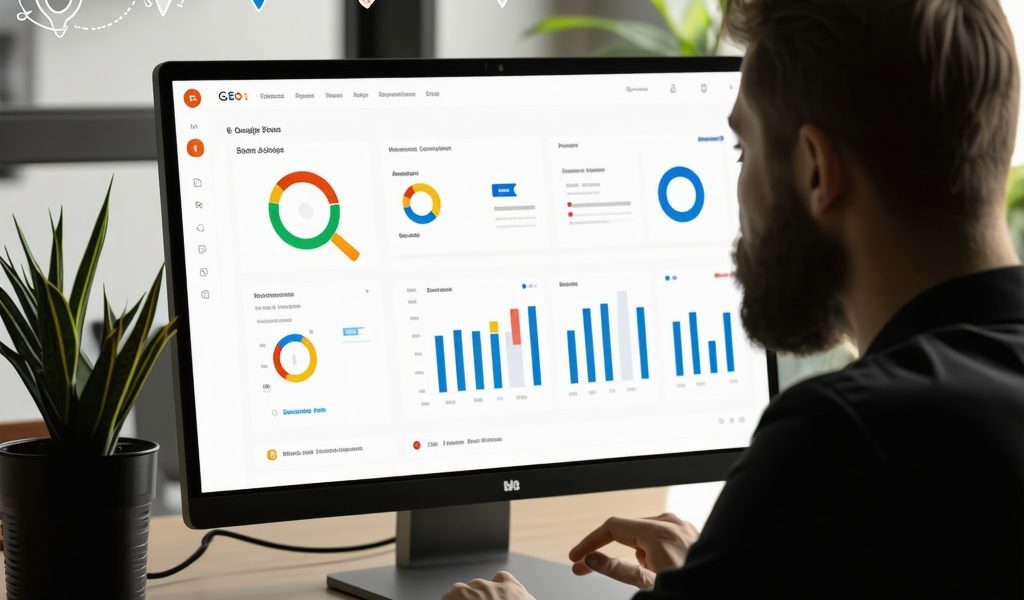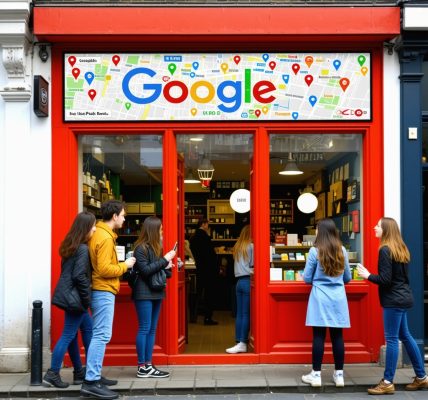Unlocking the Power of Google My Business Analytics for SEO Excellence
In the hyper-competitive landscape of local SEO, mastering the art of tracking your Google My Business (GMB) performance is indispensable for sustained visibility and customer engagement. While GMB offers a wealth of performance data, extracting actionable insights requires a nuanced understanding of key metrics and advanced analytical strategies. This article delves into expert methodologies for monitoring GMB effectiveness to enhance your local search engine optimization outcomes.
Decoding Essential GMB Performance Metrics Beyond the Basics
Surface-level metrics like views and clicks provide a snapshot, but advanced SEO practitioners harness deeper data layers such as customer actions, direction requests, and photo engagement rates. Tracking the ratio of direct versus discovery searches reveals how well your GMB listing captures both brand-aware and new customer segments. Additionally, analyzing the interaction patterns on your posts, reviews, and Q&A sections can illuminate untapped opportunities for optimizing content relevance and local keyword targeting.
How can professionals leverage GMB Insights to refine local SEO strategies effectively?
Expert local SEOs integrate GMB Insights with external analytics platforms such as Google Analytics and BrightLocal to create a comprehensive performance dashboard. This integration enables cross-referencing user behavior from search queries to on-site conversions, providing clarity on the customer journey. Moreover, segmenting data by device type and geographic origin assists in tailoring localized campaigns and optimizing for mobile-first indexing — a critical factor given Google’s evolving algorithmic emphasis.
Advanced Tools and Techniques for Proactive GMB Performance Tracking
Employing specialized tools like BrightLocal, SEMrush, or Moz Local enables continuous monitoring of citation consistency, review sentiment analysis, and competitor benchmarking. These SaaS solutions apply machine learning algorithms to detect performance fluctuations and recommend timely optimizations. Additionally, setting up automated alerts for sudden changes in GMB metrics safeguards against negative SEO impacts or listing suspensions, ensuring your local presence remains robust.
Integrating GMB Performance Data with Broader SEO and Business KPIs
Top-tier marketers position GMB analytics within the broader context of overall SEO health and business objectives. By aligning GMB traffic and engagement metrics with revenue, lead generation, and customer retention data, businesses can quantify the tangible ROI of local SEO efforts. This holistic perspective is supported by research from the Search Engine Land Local SEO Guide, which emphasizes the strategic integration of local search data within enterprise-level decision frameworks.
For those seeking to elevate their GMB optimization tactics further, exploring our complete guide to mastering Google Business SEO offers practical insights and actionable steps.
Ready to transform your local SEO impact through precise GMB tracking? Discover advanced strategies and share your experiences with our professional community to stay ahead in the evolving local search ecosystem.
Elevate Your GMB Strategy Through Data-Driven Customer Behavior Insights
Understanding customer interactions on your Google My Business listing extends far beyond just tallying overall views or clicks. Advanced SEOs utilize behavioral analytics to dissect how users engage with various GMB features such as posts, photos, Q&A, and reviews. For instance, analyzing click-through rates on specific posts or the frequency of photo views can reveal which content resonates most with your local audience. This nuanced data empowers businesses to tailor their content strategy dynamically, optimizing for the keywords and themes driving actual engagement. Additionally, tracking the timing of customer actions can identify peak engagement periods, facilitating more strategic scheduling of GMB posts and promotions.
Leveraging Machine Learning and Automation to Amplify GMB SEO Performance
Incorporating machine learning-driven tools into your GMB management workflow is a game-changer for staying competitive. Platforms like BrightLocal and Moz Local don’t just aggregate data; they analyze patterns and predict trends that human analysts might overlook. By automating routine tasks such as citation management, review solicitation, and competitor monitoring, these tools free up valuable time for strategic decision-making. Moreover, machine learning algorithms can detect subtle shifts in local search landscapes, enabling preemptive adjustments to your GMB optimization tactics before performance dips occur. Integrating these technologies with your existing SEO toolkit ensures a proactive stance rather than reactive corrections.
What Are the Most Effective Ways to Integrate GMB Insights with Multi-Channel Marketing for Holistic Local Growth?
From an expert perspective, the power of GMB analytics is magnified when combined with insights from other marketing channels such as email campaigns, social media, and paid search. Cross-platform data integration allows marketers to map the entire customer journey—from discovery through conversion—thereby identifying touchpoints that influence local buying decisions. For example, combining GMB direction requests data with social media engagement metrics can help pinpoint geographic areas for hyper-local advertising. Furthermore, syncing GMB review sentiment analysis with customer feedback from other channels enhances reputation management strategies. This holistic approach not only boosts local SEO rankings but also fosters stronger community relationships and brand loyalty.
Industry leaders like Moz emphasize the importance of this integrated approach, noting that “local SEO success increasingly depends on how well businesses connect their Google My Business data with broader digital marketing efforts” (Moz Google My Business SEO Guide).
Practical Steps to Implement Advanced GMB Analytics for Sustained Competitive Advantage
To operationalize these insights, start by setting up custom dashboards that aggregate your GMB data alongside Google Analytics and CRM metrics. Use tools like Google Data Studio to visualize trends and segment performance by location, device, and customer demographics. Regularly audit your GMB listing for data accuracy and completeness, ensuring alignment with your broader SEO strategy as outlined in our GMB SEO Audit guide. Additionally, establish a feedback loop involving your customer service and marketing teams to act swiftly on insights derived from review trends and question responses.
Engage with our community by sharing your experiences or challenges in mastering GMB analytics. Comment below to exchange advanced tactics or suggest topics for deeper exploration. For a comprehensive dive into optimizing your Google Business Profile, explore our detailed resource on effective GMB listing optimization.
Predictive Analytics: Foreseeing Trends to Optimize Google My Business Performance
Advanced local SEO professionals are increasingly turning to predictive analytics to anticipate shifts in customer behavior and search patterns related to Google My Business (GMB). Rather than merely reacting to past performance, predictive models utilize historical GMB data combined with external factors such as seasonal trends, local events, and competitor activity to forecast future engagement metrics. This proactive stance enables businesses to strategically schedule posts, adjust service offerings, and tailor promotional campaigns for maximum impact.
For example, by analyzing spikes in direction requests and phone calls during specific periods, predictive tools can suggest optimal times for launching targeted advertisements or updating GMB posts with relevant keywords that align with anticipated search intent. Leveraging time series analysis and machine learning algorithms, these insights empower marketers to move beyond intuition and establish data-driven local SEO roadmaps.
How do predictive analytics reshape the approach to managing GMB listings in dynamic local markets?
In dynamic markets, where consumer preferences and competitive landscapes evolve rapidly, predictive analytics provide a crucial advantage. By integrating GMB data with external datasets such as weather patterns, local event calendars, and economic indicators, businesses can fine-tune their listings to capture transient demand. For instance, a restaurant might anticipate increased foot traffic before a major festival and adjust its GMB description to highlight special menu items or extended hours accordingly.
Moreover, predictive analytics can highlight emerging negative trends—like declining review sentiment or reduced engagement—allowing for timely interventions such as reputation management campaigns or content refreshes. According to a study published by the International Journal of Information Management, integrating predictive analytics with customer engagement data significantly enhances localized marketing effectiveness by up to 30%. This underscores the transformative potential of predictive insights in elevating GMB strategy from reactive to anticipatory.
AI-Driven Content Personalization: Tailoring GMB Listings to Micro-Local Audiences
Artificial Intelligence (AI) technologies now enable unprecedented levels of content personalization within GMB listings. By analyzing granular user data such as search queries, device types, and previous interaction patterns, AI algorithms can recommend customized content variations that resonate with specific micro-local segments. This might include dynamically adjusting business descriptions, featured services, or promotional offers based on neighborhood demographics or time-specific behaviors.
For instance, an AI-powered system might detect that users searching from a nearby tech park frequently look for Wi-Fi availability and subsequently highlight this feature prominently on the GMB profile during business hours. Similarly, AI can optimize photo galleries by prioritizing images that historically yield higher engagement from certain demographics, thereby driving a more compelling local brand presence.
Bridging GMB Data with Voice Search Analytics for Future-Ready Local SEO
As voice-activated devices proliferate, voice search represents a rapidly growing channel through which consumers discover local businesses. Integrating GMB insights with voice search analytics is an emerging frontier for expert SEOs aiming to capture this audience. Voice queries tend to be more conversational and question-based, which necessitates optimizing GMB Q&A sections, posts, and descriptions to reflect natural language and long-tail keywords.
Combining GMB performance data with voice search intent analysis allows marketers to identify commonly asked questions and tailor content to address these queries explicitly. This approach not only improves visibility in voice search results but also enhances user experience by providing immediate, relevant information.
Industry research by BrightLocal reveals that 58% of consumers use voice search to find local business information, highlighting the critical need for voice-optimized GMB profiles.
Implementing Continuous Improvement Cycles Using GMB Data Feedback Loops
To maintain a competitive edge, businesses must develop continuous improvement cycles that leverage GMB analytics as a feedback mechanism. This involves setting up iterative processes where performance data is regularly reviewed, hypotheses for optimization are tested, and outcomes are measured against predefined KPIs.
For example, a business might experiment with varying post frequencies, adjusting call-to-action phrasing, or updating photo content, then use GMB Insights to evaluate which changes drive higher engagement or conversions. Integrating these cycles with Agile marketing frameworks fosters a culture of data-driven experimentation and rapid adaptation.
By institutionalizing such feedback loops, local businesses ensure that their GMB profiles evolve in alignment with shifting consumer preferences and algorithmic updates, rather than becoming static assets.
Ready to leverage predictive analytics and AI to revolutionize your Google My Business strategy? Explore our advanced tutorials and join the conversation with SEO experts pushing the boundaries of local search optimization.
Unveiling the Nuances of GMB Data Segmentation for Hyper-Targeted Local Campaigns
Delving deeper into Google My Business analytics, the segmentation of data by granular user attributes such as time of day, device type, and search intent unlocks unparalleled precision in crafting local marketing initiatives. For example, dissecting mobile versus desktop user behavior can inform mobile optimization priorities, whereas analyzing peak engagement windows permits fine-tuning of post scheduling to maximize visibility during high-traffic intervals.
Strategic Cross-Channel Attribution Models Leveraging GMB Insights
Incorporating GMB data into multi-touch attribution frameworks enhances the fidelity of understanding customer pathways in localized contexts. By mapping interactions from initial discovery on GMB to conversions on owned digital properties, marketers can allocate budget and effort more judiciously across channels. Advanced attribution models, such as data-driven or algorithmic attribution, facilitate this by weighting GMB touchpoints appropriately in the conversion funnel.
How can machine learning-powered attribution models integrate GMB data to optimize local marketing investments?
Machine learning-driven attribution models utilize patterns in GMB engagement—such as direction requests, calls, and website visits—to dynamically assign credit to various touchpoints. By feeding comprehensive GMB analytics into these models, businesses gain the ability to predict which local SEO activities yield the highest ROI. This empowers marketers to reallocate resources towards campaigns that demonstrably drive foot traffic and conversions, transcending conventional last-click attribution biases.
Collaborative Synergies Between GMB Data and Customer Relationship Management (CRM) Systems
Integrating GMB insights with CRM platforms fosters a holistic view of customer interactions, marrying online discovery data with offline sales and support history. This synthesis allows businesses to personalize follow-up communications based on real-time engagement signals gleaned from GMB metrics, enhancing customer retention and lifetime value. Additionally, CRM integration aids in segmenting audiences for hyper-localized remarketing efforts grounded in GMB interaction patterns.
Utilizing Geo-Fencing and Proximity Marketing Tactics Informed by GMB Analytics
By harnessing location-based data derived from GMB metrics such as direction requests and local queries, businesses can deploy geo-fencing strategies to target audiences within specific physical perimeters. This technique empowers marketers to deliver timely, contextually relevant promotions via mobile devices when potential customers are in close vicinity, thereby increasing conversion probability. The precision of these campaigns is significantly enhanced when synchronized with GMB insights that reflect real consumer movement and intent.
For an exhaustive exploration of leveraging geo-fencing in tandem with GMB data, refer to the authoritative insights offered by the Local Search Forum’s advanced geo-marketing discussions.
Elevate Your Local SEO Strategy by Integrating Advanced GMB Analytics—Join the Expert Dialogue
Embracing these advanced methodologies transforms Google My Business from a static listing into a dynamic, data-informed growth engine. Engage with fellow SEO professionals and industry leaders by sharing your experiences or questions in specialized forums and professional networks. Harness the power of integrated analytics and machine learning to stay at the forefront of local search innovation.
Seize the opportunity to revolutionize your local SEO approach with cutting-edge GMB analytics integration. Connect with experts, exchange insights, and propel your business to new heights in local search dominance.
Expert Insights & Advanced Considerations
Harnessing Predictive Analytics for Proactive Local SEO
Incorporating predictive analytics into your Google My Business strategy transforms raw data into foresight. By leveraging historical GMB metrics alongside external variables like seasonal trends and local events, businesses can anticipate customer behavior and adjust their listings proactively. This approach allows for timely content updates and promotional scheduling that captivate local audiences before demand peaks, ensuring sustained competitive advantage.
Integrating AI-Driven Personalization to Micro-Local Segments
Artificial Intelligence enables dynamic tailoring of GMB content to nuanced micro-local audiences. By analyzing user-specific signals such as device type, search patterns, and geographic micro-segments, AI-powered tools recommend customized business descriptions, featured services, and promotional offers. This granular personalization fosters stronger engagement and relevance, elevating local search rankings and brand resonance within hyper-targeted communities.
Synergizing GMB Data with Multi-Channel Attribution Models
Advanced marketers enhance local campaign effectiveness by embedding GMB insights into sophisticated multi-touch attribution models. Machine learning algorithms assess the impact of GMB interactions—calls, direction requests, website visits—across the customer journey, enabling precise ROI measurement. This data-driven allocation of marketing resources optimizes spend and prioritizes strategies that demonstrably drive foot traffic and local conversions.
Implementing Continuous Improvement Feedback Loops
Establishing iterative cycles informed by GMB analytics fosters a culture of ongoing optimization. Regularly testing variations in posts, call-to-actions, and media content, then evaluating outcomes through GMB Insights, allows businesses to respond agilely to evolving consumer preferences and algorithm changes. This disciplined, data-centric process ensures your Google My Business profile remains a dynamic asset rather than a static listing.
Leveraging Geo-Fencing Informed by GMB User Behavior Data
Utilizing location-based insights from direction requests and local queries empowers hyper-local marketing through geo-fencing. By targeting potential customers in real-time within precise geographic perimeters, businesses can deliver contextually relevant offers that heighten conversion rates. Synchronizing geo-fencing initiatives with GMB analytics refines audience targeting and maximizes the efficiency of local mobile marketing campaigns.
Curated Expert Resources
Search Engine Land Local SEO Guide: A definitive resource providing comprehensive strategies for integrating local search data within enterprise-level marketing frameworks, ideal for understanding broader SEO implications.
Moz Google My Business SEO Guide: Offers advanced insights into combining GMB data with wider digital marketing channels, emphasizing holistic local SEO success through integrated analytics.
BrightLocal Local Consumer Review Survey: Presents critical consumer behavior data reflecting the growing influence of voice search and review management on local SEO performance.
International Journal of Information Management: Features peer-reviewed research on the efficacy of predictive analytics in enhancing localized marketing effectiveness by up to 30%.
Local Search Forum Geo-Marking Discussions: An authoritative forum for advanced practitioners exploring geo-fencing and proximity marketing tactics informed by GMB data.
Final Expert Perspective
Mastering Google My Business analytics requires moving beyond surface metrics to embrace predictive insights, AI-driven personalization, and integrated multi-channel attribution. These sophisticated strategies empower businesses to anticipate market shifts, tailor content at the micro-local level, and allocate resources with precision. By institutionalizing continuous feedback loops and leveraging geo-fencing informed by GMB data, local SEO practitioners can transform their listings into dynamic growth engines that adapt to evolving consumer behaviors and algorithmic updates. Dive deeper into these advanced methodologies by exploring our complete guide to mastering Google Business SEO and join the professional conversation to sharpen your competitive edge in local search optimization.


